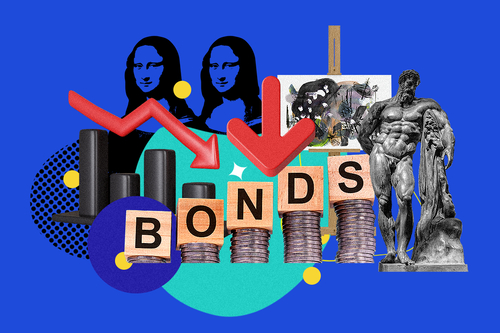

Why Bonds and Fine Art Might Be the Best Assets During a Recession
Our study found that bonds and fine art are negatively correlated with the S&P 500, thus enhancing their diversification benefits.
Updated Apr 26, 2022
Many companies on MoneyMade advertise with us. Opinions are our own, but compensation and in-depth research determine where and how companies may appear.
Art
Bonds
Balanced Investing
Talk of a potential stock market crash has been swelling for several years now. Amid periodic sell-offs and a rush to alternative assets, investors have one central question on their minds: How can I protect my portfolio?
Perhaps surprisingly, demand for fine art has historically been very resilient, meaning that it isn't significantly impacted by economic downturns.
Looking at asset correlation has long been a favorite technique for creating a diversified portfolio that can withstand dips in the stock market. Assets with a low correlation to the stock market tend to move independently of market patterns, which gives a portfolio the chance to remain stable under poor market conditions.
However, some investors will also seek out negatively correlated assets—those that move in opposite directions from the stock market—in an attempt to achieve some level of growth when stocks are down. These are assets that have historically gained value when stock prices fall. Our asset correlation study found that in recent years, two asset classes have provided this: bonds and art.
Stocks and bonds: negative correlation can boost diversification benefits
Stocks and bonds: negative correlation can boost diversification benefits
Bonds have long been the easiest and most obvious way to diversify a portfolio and for good reason. While they rarely offer anything impressive in terms of growth, they do tend to serve as a safe haven asset that can shield investors from loss. A negative correlation is even more helpful to investors, because it increases the diversification benefits of holding bonds.
This negative correlation between stocks and bonds has certainly held true in recent years. Our study looked at Treasury yield rates from 2018 to 2021 and found they were inversely correlated to the S&P 500, with a Pearson correlation coefficient of -0.3380. Of all 17 different asset classes our study looked at, bond yields showed the second most inverse correlation to stocks.
Even in the first quarter of 2022, during concerns about high inflation and stock market volatility, the 10-year Treasury yield soared to rates not seen since 2018. Some even argued it was the best time to buy government bonds since 2015.
Bond yields haven't always been inversely correlated with stocks. There are been periods in history, particularly before 1997, when bonds and stocks were positively correlated. However, the two asset classes have largely moved in opposite directions for the past couple of decades, making them excellent hedges against eachother.
Fine art's inverse correlatation with stocks
Fine art's inverse correlatation with stocks
Investment-grade art, as measured by the Artprice Global Index, came out as the asset with the highest negative correlation to the stock market in our study. The correlation coefficient of -0.6350 found between art and stocks suggests that the two assets moved in nearly complete opposite directions between 2018 and 2021. The Artprice Global Index we used is calculated based on blue-chip art auction results across a variety of mediums (painting, sculpture, photography, drawing, and print) and stylistic periods (old masters, 19th century, modern art, post-war, and contemporary).
Over the long-run, art has largely been shown to be uncorrelated with the stock market. Perhaps surprisingly, demand for fine art has historically been very resilient, meaning that it isn't significantly impacted by economic downturns. For example, while auction prices fell 27% from 2007-2009, during the Great Recession, this was nothing compared to the 57% decrease in the S&P 500 over the same period. In fact, the volume of sales in the art market wasn't even noticeably impacted by the financial crisis until 2009, once stock prices had begun to rebound.
Our findings suggest that fine art has been even more inversely correlated with stocks in recent years than in the past. And unlike bonds, which generally yield single digits even in the best of bond markets, the best fine art investments have the potential to delivery outsized returns. For example, between the years of 1995 to 2000, contemporary art delivered annualized returns of 14%, outperforming the S&P 500's 9.5% annualized price appreciation.
Of course, purchasing investment-grade art has been a challenge for investors in the past. It requires significant capital, especially if you plan to diversify your holdings within the art market. Even investors with enough funds struggle to gain enough knowledge of the nuances of the art market to make sound investment decisions.
New investing platforms like Masterworks that allow for fractional ownership have made investing in fine art more accessible. With Masterworks, for example, you can invest in blue-chip art like Banksy's Mona Lisa or Andy Warhol's Dollar Sign by purchasing shares in the artwork for as little as $500.
Masterworks
4.7
•
Art
As alternative assets become more widely available to investors of all types, the possibilities for building a diversified portfolio expand exponentially. As asset allocation becomes increasingly more complex with the incorporation of alternatives like fine art, cryptocurrency, and even sports cards, looking at asset correlation to determine the best way to diversify is more important than ever.